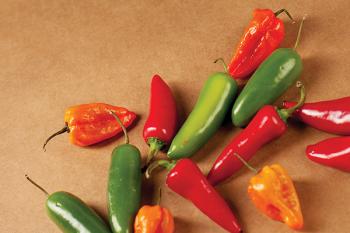
AgCenter: Plant popular peppers
Louisianans have appreciated the enjoyable qualities of spicy foods for generations. The fire in Louisiana cooking is provided primarily by the use of hot peppers or products made from them like red pepper and hot sauce. A backyard garden wouldn’t be complete without a few pepper plants — hot and sweet — to pick from.
The pepper is native to the tropics of Central and South America and has probably been cultivated for thousands of years. When Columbus reached the Caribbean, he tasted a vegetable being grown by the native population. Its sharp taste reminded him of the familiar black pepper so he called the new plant “pepper,” as we do today. Columbus, however, was no botanist and was mistaken. The plant was not even related to black pepper — Piper nigrum — but belongs to an entirely different genus, Capsicum.
From their America origins, peppers were spread to Europe, Africa, India and Asia, and became an important part of many regional cuisines. They are a member of the Solanaceae or Nightshade family, which makes them relatives of the tomato, potato, tobacco, eggplant and petunia.
The degree of heat in a pepper is related to the amount of capsaicin in the fruit. This chemical is concentrated in the pepper pod where the seeds are attached and in the veins of the inner wall. Peppers are at the peak of their hotness when fully ripe and are usually five times hotter when they are mature compared to the green or immature fruit.
Based on the amount of capsaicin they generally contain, pepper varieties can be classified as sweet, mild, hot and very hot. Remember, you cannot always identify a hot pepper by its shape or color. Here’s how the popular peppers stack up:
—Sweet: Bell peppers, pimento, sweet banana and gypsy.
—Mild: Mexi-Bell, cherry, NuMex Big Jim, anaheim, ancho, pasilla, espanola and cascabell.
—Hot: jalapeno, mirasol, Hungarian wax (hot banana), derrano, cayenne and tabasco.
—Very Hot: Chiltepin, Thai, habanero, Scotch bonnet.
Bell peppers are commonly planted in the home garden. They are blocky in shape with three or four lobes on the bottom of the pepper. Though we generally harvest bell peppers green, we can harvest them when they are ripe and have turned red, yellow or orange.
Recommended non-hybrid (open-pollinated) bell pepper varieties for Louisiana include Jupiter, Capistrano and Purple Beauty. The best hybrid bell peppers for Louisiana are Camelot X3R, Excursion II, Heritage, King Arthur, Plato, Paladin, Revolution, Aristotle X34, Purple Bell, Tequila and Purple Beauty. All-America Selections-winning hybrid bells are Super Heavy Weight, Blushing Beauty, Bell Boy and the piquant Mexibell.
Many pepper varieties are attractive enough to use as ornamentals in the landscape as well as in the vegetable garden. Indeed, a number of varieties called “ornamental peppers” have been selected for the colorful fruit or foliage. The fruit of ornamental peppers is perfectly edible, although generally quite hot.
Growing peppers
Mid-March to mid-April is an ideal time to plant peppers in the garden. Bell peppers are more sensitive to heat than other types of peppers, so plant early in the spring garden season. Hot peppers and other sweet peppers are much more heat-tolerant and can be planted through the summer.
Choose a sunny area because peppers need full sun to blossom and set fruit. Also try to select a spot protected from the wind because pepper plants have shallow root systems and brittle branches. In mid-to-late summer, a stake will help keep the plant upright as it grows taller.
Plant peppers in well-drained beds enriched by digging in compost and an all-purpose fertilizer. Once they are planted, water in the pepper transplants with your favorite soluble fertilizer. Sidedress pepper plants with additional fertilizer every four to six weeks with one tablespoon per plant.
Space peppers 1½ to 2 feet apart. Depending on the variety, most peppers grow about 2 to 3 feet tall. Six plants — four sweet, one mild and one hot — should provide a family with a summer-long crop of peppers. Bell pepper production often drops off in the hottest part of the summer but will pick back up as weather cools in September. Excellent summer production of sweet peppers can be obtained from gypsy and sweet banana varieties.
Mulch plants to control weeds and conserve moisture. Leaves, pine straw or dried grass clippings work fine.
Peppers can be harvested at any stage of development. Bell types are usually harvested when firm and full-size but still green. They may also be harvested when mature and turn red, orange or yellow, depending on variety. With other types of peppers, harvest varies.
Jalapenos are generally harvested green, while cayenne peppers are harvested mature red. But it’s largely up to you to decide. When harvesting the fruit, hold the branch and snap or cut the fruit off carefully. Pepper plants are brittle and break easily.
- Log in to post comments
